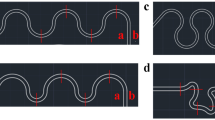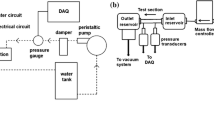Abstract
Present study examines the flow characteristics of open microchannels with sharp turns by experimental and numerical methods. For the open channel system in microscale, the flow is mainly driven by surface tension at atmospheric pressure. The open channels are of various aspect ratios of depth-to-width, ranging from 0.75 to 3, and of turning angles from 45° to 135°. It is found that the turning angle and the aspect ratio of depth-to-width play major roles in the velocity of liquid front advancing, the meniscus of liquid–gas interface shape, and head loss of flow due to turning. Besides, the radius of curvature of the liquid front is reduced as the liquid front travels downstream and over the turning elbow. The loss coefficient remains the same for turning angles less than 75°, whereas it is increased further and is even more pronounced for turning angles larger than 105°. Numerical predications based on conservation laws agree with the experimental observations, and the flow characteristics are well described for open channel in microscale, as the aspect ratio is greater than or near to 1.5.











Similar content being viewed by others
References
Adamson AW (1990) Physical chemistry of surfaces. Wiley, New York
Beebe DJ, Adrian RJ, Olsen MG, Stremler MA, Aref H, Jo BH (2001) Passive mixing in microchannels: fabrication and flow experiments. Mech Ind 2:343–348
Brackbill JU, Kothe DB, Zemach C (1992) A continuum method for modeling surface tension. J Comp Phys 100:335–354
Cheng JH, Tseng YT, Tseng FG, Lin WK, Chieng CC (2005) Self-driven flow loop in microscale. J Chin Soc Mech Eng 26(1):19–26
Dutta D, Ramachandran A, Leighton DT (2006) Effect of channel geometry on solute dispersion in pressure-driven microfluidic systems. Microfluid Nanofluid 2:275–290
Fujimura T, Ikeda A, Etoh SI, Hattori R, Kuroki Y, Chang SS (2003) Fabrication of open-top microchannel plate using deep X-ray exposure mask made with silicon on insulator substrate. Jpn J Appl Phys 42:4102–4106
Gobby D, Angeli P, Gavriilidis A (2001) Mixing characteristic of T-type microfluidic mixers. J Micromech Microeng 11:126–132
Herr AE, Molho JI, Santiago JG, Mungal MG, Kenny TW (2000) Electroosmotic capillary flow with non-uniform zeta potential. Anal Chem 72:1053–1057
Huang W, Bhullar RS, Fung YC (2001) The surface-tension-driven flow of blood from a droplet into a capillary tube. J Biomech Eng 123(5):446–454
Kim SM, Lee W, Suh KY (2006) Evolution of transient meniscus in a wettable microchannel for Newtonian fluid. J Micromech Microeng 16:2692–2696
Kirby BJ, Hasselbrink EF (2004a) Zeta potential of microfluidic substrates: 1. Theory, experimental techniques, and effects on separations. Electrophoresis 25(2):187–202
Kirby BJ, Hasselbrink EF (2004b) Zeta potential of microfluidic substrates: 2. Data for polymers. Electrophoresis 25(2):203–213
Koo J, Kleinstreuer C (2003) Liquid flow in microchannels: experimental observations and computational analyses of microfluidics effects. J Micromech Microeng 13:568–579
Kothe B, Rider WJ, Mosso SJ, Brock JS (1996) Volume tracking of interfaces having surface tension in two and three dimension. In: Proceedings of the 34th aerospace science meeting and exhibition. AIAA 0859:1–24
Lin CH, Lee GB, Chang BW, Chang GL (2002) A new fabrication process for ultra-thick microfluidic microstructures utilizing SU-8 photoresist. J Micromech Microeng 12:590–597
Liu RH, Stremler MA, Sharp KV, Olsen MG, Santiago JG, Adrian RJ, Aref H, Beebe DJ (2000) Passive mixing in a three-dimensional serpentine microchannel. J Microelectromech Syst 9:190–197
Lo YC, Huang CS, Hsu W, Wang C (2004) Neural guidance by open-top SU-8 microfluidic channel. In: Proceedings of the 2004 international conference on MEMS, NANO and Smart System (ICMENS 2004), pp 671–674
Mitsuishi M, Mihashi M, Aminuzzaman M, Miyashita T (2004) Surface modification of microchannels with fluorinated polymer langumuir-blodgett films. Mol Cryst Liq Crust 424:273–277
Nguyen NT, Huang XY, Chuan TK (2002) MEMS micropumps: a review. J Fluid Eng 124(2):384–392
Nilson RH, Tchikanda SW, Griffiths SK, Martinez MJ (2006) Steady evaporating flow in rectangular microchannels. Int J Heat Mass Transf 49(9–10):1603–1618
Rider WJ, Kothe DB (1995) Stretching and tearing interface tracing methods. In: Proceedings of the 33rd aerospace science meeting and exhibition. AIAA 1717:1–11
Steinke ME, Kandlikar S G (2006) Single-phase liquid friction in microchannels. Int J Therm Sci 45:1073–1083
Takei G, Nonogi M, Hibara A, Kitamori T, Kim HB (2007) Turning microchannel wettability and fabrication of multiple-step Laplace valves. Lab Chip 7:596–602
Tseng FG, Lin KH, Hsu HT, Chieng CC (2004) A surface-tension-driven fluidic network for precise enzyme batch-dispensing and glucose detection. Sens Actuators A 111(1):107–117
Wang CC, Chen IY, Huang PS (2005) Two-phase slug flow across small diameter tubes with the presence of vertical return bend. Int J Heat Mass Transf 48:2342–2346
Wang KG, Yue S, Wang L, Jin A, Gu C, Wang PY, Feng Y, Wang Y, Niu H (2006) Manipulating DNA molecules in nanofluidic channels. Microfluid Nanofluid 2:85–88
Wang LL, Yang JT, Lyu PC (2007) An overlapping crisscross micromixer. Chem Eng Sci 62(3):711–720
White FM (1988) Fluid mechanics, 2nd edn. Mcgraw-Hill, Singapore, pp 148, 334
Wu HY, Cheng P (2003) Friction factors in smooth trapezoidal silicon microchannels with different aspect ratios. Int J Heat Mass Transf 46:2519–2525
Yang WH, Zhang JZ, Cheng HE (2005) The study of flow characteristics of curved microchannel. Appl Therm Eng 25:1894–1907
Yang ID, Chen YF, Tseng FG, Hsu HT, Chieng CC (2006) Surface tension driven and 3-D vortex enhanced rapid mixing microchamber. J Microelectromech Syst 15(3):659–670
Acknowledgments
The authors highly appreciate the supports from Department of Industry of the Ministry of Economic Affairs, and National Science Council, Taiwan under contract NSC95-2323-B-007-004.
Author information
Authors and Affiliations
Corresponding author
Rights and permissions
About this article
Cite this article
Chen, YF., Tseng, FG., ChangChien, SY. et al. Surface tension driven flow for open microchannels with different turning angles. Microfluid Nanofluid 5, 193–203 (2008). https://doi.org/10.1007/s10404-007-0237-5
Received:
Accepted:
Published:
Issue Date:
DOI: https://doi.org/10.1007/s10404-007-0237-5




